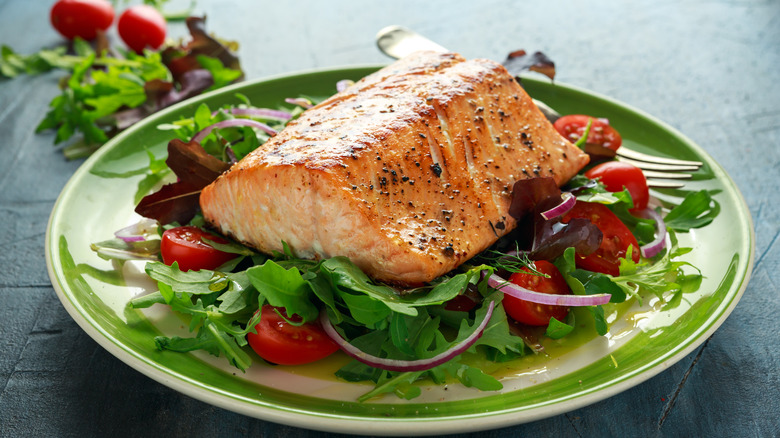How Much Salmon Is Safe To Eat In A Week?
Fish is considered a high-quality protein offering numerous health benefits, but since the 1950s, scientists have been raising legitimate concerns that eating too much can expose us to dangerous environmental contaminants, including mercury, polychlorinated biphenyls (PCBs), chlordane, and DDT. Some species of fish have been deemed safer than others in this regard, however. And fortunately for Tasting Table readers — nearly half of whom regard salmon as their favorite fish to cook – salmon is known to harbor lower concentrations of contaminants compared with many other fish, including snapper, halibut, Chilean sea bass, mahi-mahi, and yellowfin tuna, all of which are nevertheless considered to be generally "safe" choices when eaten in moderation.
Indeed, both the U.S. Food and Drug Administration (FDA) and Environmental Protection Agency (EPA) regard salmon as among the "best choices" one can make when it comes to fish consumption, according to the Keck School of Medicine at USC (KSM). But even these may harbor contaminants. Salmon, in particular, may contain low levels of mercury, which can build up in the body over time. Resulting mercury toxicity can cause a variety of neurological problems, including vision and hearing impairment, neuropathy, loss of coordination and strength, and difficulty speaking.
Accordingly, for optimal health benefits, experts recommend that most adults consume no more than eight to 12 ounces of salmon per week. However, other guidelines may apply to you and some members of your family.
Some populations are advised to limit their salmon consumption further than the general recommendation
For the general population, consuming eight to 12 ounces of salmon per week is considered ideal in terms of balancing the significant health benefits associated with its consumption with the low but actual risk of mercury contamination. However, when it comes to certain populations, the amount of salmon that can be safely consumed in a week may be somewhat smaller.
Specifically, for children between the ages of one and three, the FDA advises limiting salmon intake to two one-ounce servings per week. For children between the ages of four and seven, that goes up to two two-ounce servings twice per week. For children between the ages of eight and 10, two three-ounce servings of salmon are considered ideal. Once a child reaches age 11, the FDA recommends two four-ounce servings per week. Most adults can safely consume up to 12 ounces per week.
However, concerns about contaminants aside, adults looking to limit cholesterol intake might benefit from limiting their salmon intake to eight ounces per week, according to Alaskan Salmon Co. The same is true of diabetics, those with gout, and those looking to reduce their caloric intake. But the good news is, as long as you stick to the above-referenced guidelines, you're welcome to keep the skin on.

